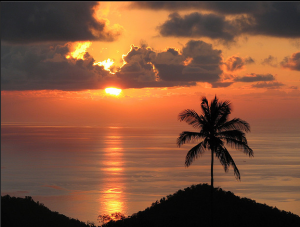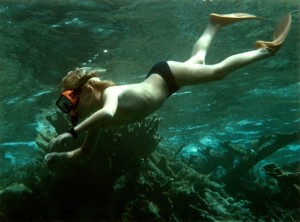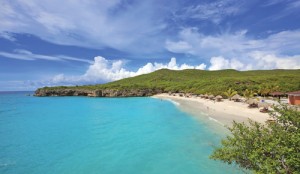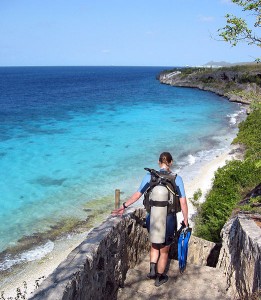History and Geography
Bonaire Island is not big but it’s not a speck either; it covers 111 sq mi (294 sq km) which is enough for a small colony of locals. expats and visitors. It is is a special ‘municipality’ of the Netherlands, a mere 4416 miles (7108km) away so it not likely the Queen’s guard will be visiting–about the same distance from Amsterdam to Katmandu, Nepal. The permanent population is about 15,000. The main town is Kralendijk.
 There is a nearby tiny uninhabited islet called Klein Bonaire, 2.3 sq mi big (6 km²) that offers beaches and scrub forest and reef diving under water. The reef is particularly well preserved so it draws divers, snorkelers, and boaters from around the world.
There is a nearby tiny uninhabited islet called Klein Bonaire, 2.3 sq mi big (6 km²) that offers beaches and scrub forest and reef diving under water. The reef is particularly well preserved so it draws divers, snorkelers, and boaters from around the world.
The island’s earliest settlers, around 1000, were probably the Caquetio Indians, related to the Arawak from Venezuela. Any queer anthropologist would be curious if and what non-conforming erotic practices were indigenous to those tribes. ‘Two-Spirit’ people are known to have lived among many early tribes in Central America. Male and female Two-Spirits have been “documented in over 130 tribes, in every region of North America.”
Five hundred years later the Europeans started arriving bring conquest, deportation, disease and a totally new type of civilization, including sexual traditions. First the Spanish, followed by the Dutch then the British and back to the Dutch in 1814, with slavery abolished in 1862. But since the island was by then owned by two powerful unkind families many of the workers were forced to move to Aruba, Curaçao, or Venezuela.
On 10 October 2010 the Netherlands Antilles (a multi-island amalgam country) was dissolved, making Aruba and Curacao autonomous states and Bonaire a municipality of the Netherlands.

Tourist Economy
Bonaire’s economy is mainly based on tourism. The island is ringed by a coral reef and is world renowned for its excellent scuba diving which is easily accessible from the shore along the Western and Southern sides. (photo right) The entire coastline of the island has been declared a marine sanctuary, preserving the beautiful fish and intricate coral life.
http://en.wikipedia.org/wiki/Bonaire
Much of the tourism infrastructure in Bonaire is contemporary and based on time-share resorts; one is listed in Purple Roofs as gay owned. There are a few small bed and breakfasts. Access is easy; the airport is known as Flamingo International Airport and is currently served by a variety of both Domestic and International Airlines.
 The airport is so named because Bonaire is also famed for its huge flamingo population which, it has been reported, rivals the human one in number.
The airport is so named because Bonaire is also famed for its huge flamingo population which, it has been reported, rivals the human one in number.
Although there are not typical long Caribbean miles of sand beaches on Bonaire, there are numerous specific small picturesque spots; most beaches on Bonaire are public. Little Bonaire has more sandy beaches that can be reached by water tax from Kralendijk town on big Bonaire.
Gay Life
There is no organized gay life in Bonaire unless you bring it (him or her) with you on the boat from Curacao or Aruba–or by sheer accident find a friendly beach wanderer or scuba diver on your gaydar. (Does gaydar work under water!?)
Bonaire is within the Netherlands domain and is governed by the laws of that country which includes recognition of legalized gay marriage. However, ‘authorized’ gay marriage ceremonies do not take place on the island. Anti-gay discrimination is virtually unheard of, at least in general. Like anywhere, homophobic individuals can be found in all countries in the Caribbean, some worse than others, some better. It ranges from dangerous in Jamaica to benevolent in Curacao.

Despite its Dutch-liberal affiliation, nude recreation in Bonaire is illegal and offensive to the local population, with the one exception of Sorobon Beach which is a nudist resort. Topless sunbathing is mostly ignored on beaches where there is little or no local population (i.e., straight families). However, at popular local beaches topless/nudity is unacceptable.
http://www.visit-bonaire.eu/pagina.asp?pagina=4&website=bonaireeng
Close-up information about lGBT life in Bonaire is not common since it is mostly an individual or couple experience–not a group or organized thing. Like a million other non-gay-non-homophobic settings, gatherings or parties are simply a network of friends and acquaintances who have connected casually by word of mouth with like-minded others. That is, like-minded others who do not mind if a few others know about their interests in same-sexers but are not ready to organize or advocate for equality rights.
Also like a million other places, there are LGBTs hidden away within the majority straight population, closeted folks who cannot reveal their truth to their peers or family out of fear of rejection, humiliation or dishonor. Bonaire is no exception but accessing these folks as an outside visitor, or worse, as a journalist, is very difficult. The common arrangement is to get married and have kids, with an occasional ‘down-low’ quickie or a very secret love affair. Another alternative for these inhibited people is to migrate to Curacao, or beyond, where there is a bigger city and the anonymity provided by a large population. Curacao’s capital of Willemstad has over 140,000 people and a modest yet active LGBT community.
Passport magazine had a short and insightful report on this tiny island in which writer Rich Rubin quoted a local resident who said, “on Bonaire, there’s not a hell of a lot of nightlife of any kind.” Locals and tourists gather at Karel’s Bar, a colorful shed set on a mid-sea pier, or City Cafe, a seaside bar/restaurant with frequent live music. “That’s about it. A night owl’s mecca it ain’t.” The major happenings here are nature’s great undersea wonders and nightly sunsets.
Rubin also wrote, “Bonaire initiated the ‘Dive For Life’ project, an AIDS benefit first sponsored by Captain Don’s Habitat resort. The event continues annually, bringing the unique combination of awareness and fun that could be Bonaire’s calling card. It’s not surprising on this open-minded island.”
http://www.passportmagazine.com/destinations/ABC_Islands.php
By Richard Ammon
GlobalGayz.com
September 2012
Google Photo Gallery for Bonaire
















